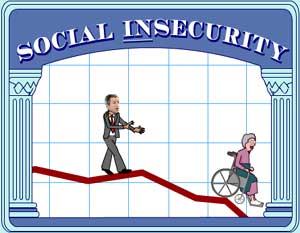An Old Tale in a New Context
Bill Sammon recalls a day, back in 2002:
When Bush visited Portland, Ore., for a fundraiser, protesters stalked his motorcade, assailed his limousine and stoned a car containing his advisers. Chanting “Bush is a terrorist!”, the demonstrators bullied passers-by, including gay softball players and a wheelchair-bound grandfather with multiple sclerosis.
One protester even brandished a sign that seemed to advocate Bush’s assassination. The man held a large photo of Bush that had been doctored to show a gun barrel pressed against his temple.
Oddly, as Sammon points out, the media that is so keen to make readers, viewers, and listeners aware of the anger of those who oppose (if I may reuse the phrase) the Democrats’ federal powergrab in a porcine “healthcare reform” costume was uninterested in Bush’s riotous reception. This, of course, is merely one example of history repeating itself with a different accent. When President Obama derides “scare tactics,” I can’t help but recall this:

That, for those who weren’t blogging seven years ago, is a screenshot from an online advertisement put out by the Democratic National Committee. Scare tactics were institutional, back in the day.
While routing around in my old archives, I came across this quotation from FBI profiler Gregg McCrary, conveyed to Washington Post readers that same month:
“White males belong to a long-advantaged group that is now having to share power and control. But I think it has less to do with race than social class.”
The context was the search for the Washington sniper. You might recall that, of the various possible profiles, the one about which we heard most frequently was of the angry white supremacist Christian militia variation. You might also recall that the snipers turned out to be black, which fact didn’t seem to matter to some aspects of the coverage:

The interesting parallel, though, comes in this paragraph from Harold Meyerson, which arrived in my morning paper the other day:
When future historians look back at this passage in our nation’s history, I suspect they’ll conclude that this Obama-isn’t-American nuttiness refracted the insecurities and, in some cases, the hatred that a portion of conservative white America felt about having a black president and about the transformation of what many thought of as their white nation into a genuinely multiracial republic. But whatever the reasons, a mobilized minority is making a very plausible play to thwart a demobilized majority.
Unsurprisingly, Meyerson’s reflections spring from the healthcare townhalls. “What’s particularly curious about these two protests,” he writes, “is that they took place on very liberal turf — Philadelphia and Austin — yet the local liberals and people of color seemed absent.” Bused-in angry white mobs, you might say. In contrast to the bused-in friendly multicultural mob with which Obama set the scene for his own townhall appearance thereby disproving the “demobilized majority” thesis.
The lesson, it would seem, is that angry whites are the villains whether they’re the majority, the minority, the origin of a particular policy, the opposition, guilty, or innocent. What ought to be as clear blue as whitey’s eyes, at this point, is that racial division has long been serving a leftist agenda, and whether there is a new, emerging majority or a left-wing minority has been deftly pulling together the strings of power, the tone has colored opposing voices not merely as wrong, but as hateful and illegitimate participants.
Those who present such a view as part of a political strategy manipulate the insecurities of the public. And although it’s a too easy psychological analysis to make, one does wonder whether those whom the manipulators thus persuade are, themselves, uncomfortable with a multicultural society, giving themselves moral credit for resisting the impulse and believing those who disagree on unrelated political matters to be succumbing to it.
(Links compiled from various sources, but conspicuously from Instapundit both then and now.)
